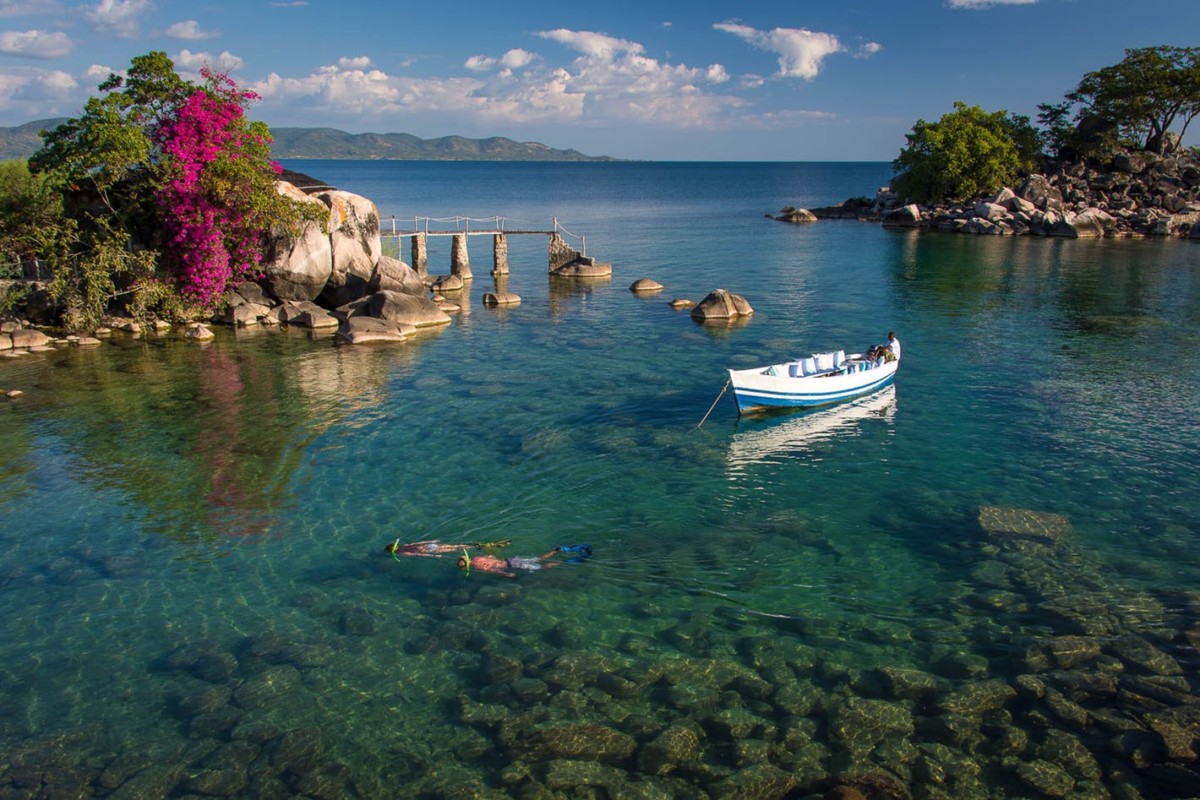Affectionately referred to as the “Warm Heart of Africa”, Malawi is beautiful and unspoilt. Known for its friendly locals, dominant lake and spectacular landscapes, it is one of the lesser-known African destinations, meaning you get to enjoy your trip without the crowds. Here are seven reasons why you’ll want to add this gem to your African bucket list.
1. Lake Malawi
Lake Malawi, called the “Lake of Stars” by Malawians, is undoubtedly the jewel in the country’s crown, taking up almost a third of the land area. It’s the third largest lake in Africa (and ninth largest in the world) and boasts hundreds of species of fish; in fact it has the highest biodiversity of freshwater fish in the world, 99% of which are endemic. Sustaining the people, animals and plant life along its shores, it’s an integral part of Malawian life as well as the perfect place to enjoy snorkelling, diving, yachting, kayaking, and of course, soaking up the rays on its golden beaches. The warm, clear waters are dotted with several islands dotted to explore including Mumbo, Likoma and Chizumulu.

2. National parks and wildlife reserves
It’s not widely known that Malawi is an up-and-coming safari destination with a number of parks and reserves offering incredible animal encounters. Liwonde National Park on the banks of the Shire River is the most established and is home to elephant, hippo, lion, monkeys and birds. Majete Wildlife Reserve is the only place in the country where you can see the Big Five, and bird-lovers can enjoy over 600 species of birds. Nkhotakota Game Reserve is ideal for both walking and canoe safaris. Other options include: Mwaza Marsh Game Reserve, Lengwe National Park, Kasungu National Park and Nyika National Park. This makes Malawi a top class beach and bush combination that feels quite exclusive and personal.

3. Mount Mulanje
65km east of the city of Blantyre is where you’ll find Mount Mulanje, Central Africa’s highest peak. The district of Mulanje is dominated by vast tea plantations, but it’s Mount Mulanje and its magnificent slopes that is the true star. Consisting of rocky green peaks, deep gorges, forest ravines and a collection of waterfalls and pools, it is a hiker’s paradise. With many well-marked trails to choose from, all featuring fabulous views, this is a must-do. Also, the national tree of Malawi is found here in abundance – the Malawian cedar.

4. Chongoni Rock Art Area
Located in the Central Region in forested hills, Chingoni consists of 127 unique sites of rock art and paintings dating back to Stone Age and the hunter-gatherers who lived then. Proclaimed a UNESCO World Heritage Site in 2006, the rock art symbolises rituals and ceremonies performed eons ago and is of great cultural importance, acting as a window into the past of the Malawian people. It is the richest concentration of rock art in Central Africa and offers a fascinating experience in history. Three of the sites, made up of a few rock shelters, are open to the public.

5. Lilongwe
Malawi also offers an urban fix, should you wish to experience some city vibes along with your beach and bush adventures. Mixing the old with the new, Lilongwe, the country’s capital city, is a hive of excitement and culture. The busy streets are bursting with restaurants serving both modern and traditional cuisine, as well as spots selling and playing local art and music. The famous markets of Old Town are amazing for souvenir shopping – hand-crafted pieces include everything from jewellery to wood carvings to decorative bowls. If it’s food and fresh produce you prefer, there are also opportunities to buy seafood, fruit and vegetables – these food markets are a real feast for the eyes.

Also worth a mention: Blantyre – the country’s commercial hub. Apart from the buzzing atmosphere, there are also a number of historical buildings of interest located here, the most impressive being the St Michael and All Angels Church, built by men with no experience in architecture or building.
6. Ntchisi Forest Reserve
Imagine a gorgeous rain forest surrounded by hills on all sides and overflowing with farmlands and traditional villages – this is Ntchisi Forest Reserve, one of the last remaining rain forest areas in the lower half of Africa. Here, the birdlife is particularly prolific, making it a premier bird-watching part of the country. Other animals such as baboons, monkeys and bushbuck, as well as butterflies, orchids and other wildflowers, all call this place home. Enjoy hiking and mountain biking as you drink in the lush surrounds.

7. Zomba Plateau
Zomba Plateau is a natural Garden of Eden. This huge slab rises to 1800 metres and is a mix of vegetation, with cypress, pine and cedar trees dominating. The flat top features a maze of crisscrossing streams dotted with still lakes and tumbling waterfalls. Driveable tracks right round the top allow you to explore the entire circumference with ease. Keep your eyes peeled for the animals that dwell here including baboons, butterflies and the rarely-sighted leopard. Birdlife is plentiful here too, with the long-crested eagle and augur buzzard being frequently seen.

Extras: You also have to be sure to catch one of the truly magical sunsets for which Malawi is also known. In fact, Malawi means “Flames of Fire” in the local dialect and when you see one of those iconic fiery-red sunsets, you’ll know why.

The local cuisine is a treat with a strong focus on fish. Try dishes such as mpasa (lake salmon), kampango (similar to catfish) and usipa (similar to sardines). Other popular dishes are fried bananas, traditional chicken stews and desserts like mandazi and zitumbuwa. The standout national dish has to be chambo and nsima – a fish and maize meal. Freshly-ground Malawian coffee as well as maltewu, a drink made from maize, is also a must-try.
Come and experience everything Malawi has to offer with us at Portfolio Journeys. Get in touch for a quote or click here to take a look at our Classic Malawi itinerary but remember, we can tailor-make your itinerary in line with your preferences and destination wishlist.






